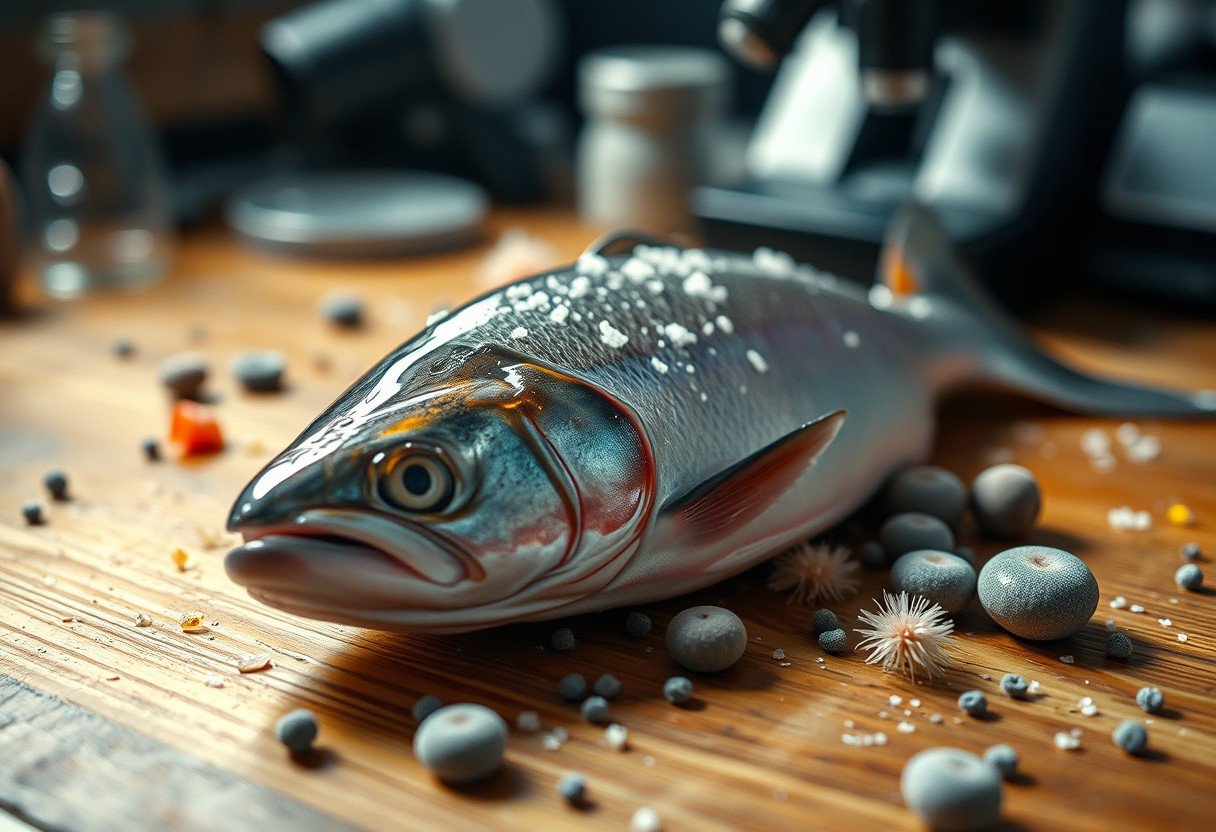Salted freshwater trout can still spoil, and the main culprits are microorganisms that tolerate salt. They come from the fish, tools, and the environment, and they grow during storage if conditions suit them. Learn what grows, where it comes from, how salt changes the micro world, when spoilage happens, who is most at risk, and why control steps work. Use the right salt level and cold storage to block most spoilage before it starts.
What Microorganisms Thrive In Salted Freshwater Trout
Salt knocks back many microbes, but some survive and grow. These include halophilic and halotolerant bacteria, salt tolerant yeasts, and molds that handle low moisture. They slowly break down proteins and fats, creating off odors and slime.
Freshwater fish can also carry psychrotrophic bacteria that grow in the cold. Some, like Pseudomonas and Shewanella, cause strong odors, especially if salt levels or temperature control slip. The species that win are the ones that tolerate high salt and low temperature while using fish nutrients.
Yeasts such as Debaryomyces can live at high salt and low moisture and change flavor. Molds like Penicillium may appear on surfaces when storage is damp or air exposed.
Why Salt Selects Halophiles And Halotolerant Spoilers
Salt lowers water activity by pulling water out of cells. Most bacteria need higher water activity to grow, so they stall. Halophiles and halotolerant microbes use special proteins and compatible solutes to survive.
As weaker microbes stop, the survivors get a clear path. They produce enzymes that soften texture and release strong smells from amino acids and fats. Salt does not sterilize fish, it changes which microbes grow.
At moderate salt, lactic acid bacteria such as Lactobacillus can sour the fish. At higher salt, Staphylococcus, Micrococcus, and salt loving yeasts become more common.
Storage Conditions That Speed Or Slow Spoilage
Temperature, humidity, and oxygen exposure decide how fast salted trout spoils. Cold slows enzymes and cells. Dry surfaces slow molds and yeasts. Tightly wrapped fish has less oxygen, which also slows many spoilers.
Keep salted trout as close to 0 degree Celsius as possible and prevent surface moisture to extend shelf life.
| Temperature | Relative Humidity | Expected Shelf Life | Typical Spoilers |
|---|---|---|---|
| 0 to 2 C | 60 to 70 percent | Longest | Halotolerant bacteria and slow growing yeasts |
| 3 to 4 C | 70 to 80 percent | Moderate | Lactic acid bacteria, Debaryomyces, surface molds |
| Above 4 C | Above 80 percent | Shortest | Shewanella, Pseudomonas, fast molds and yeasts |
Use a fridge thermometer and keep lids or wraps snug. If condensation forms, dry the surface and refresh the salt.
Key Spoilage Organisms To Watch In Salted Trout
Not all microbes behave the same in salt preserved fish. The most common spoilers fall into a few clear groups, each with typical signs. Knowing the groups helps you act before flavor and safety fail.
- Halophilic and halotolerant bacteria such as Staphylococcus, Lactobacillus, Micrococcus, and some Vibrio strains
- Salt tolerant yeasts including Debaryomyces that cause sour or yeasty notes
- Surface molds like Penicillium and Aspergillus that form colored patches
These organisms come from raw fish, handling, salt, and air. Good sanitation and correct salt levels reduce their numbers and slow growth.
Practical Steps To Prevent Spoilage At Home
Simple controls make a big difference. Aim for the right salting, cold storage, low surface moisture, and clean handling. Small improvements in temperature and salt give large gains in shelf life and safety.
- Salt thoroughly at 15 to 20 percent by weight or use a strong brine, and distribute salt evenly.
- Chill fast and store at 0 to 4 C in clean, sealed containers or vacuum packs.
- Keep surfaces dry by draining and re salting if brine pools form.
- Sanitize tools and boards before and after use to lower the starting microbial load.
- Label dates, check smell daily, and discard if strong sulfur or putrid odors appear.
If the texture turns mushy or slimy, or color dulls, review your process. More salt, colder storage, and drier surfaces are the first fixes.
How To Spot Spoilage Early And Stay Safe
Use your senses. Sour, rancid, or sulfur smells are early warnings. Slime on the surface or sticky flesh shows microbial growth.
Watch for color change and mold spots. If mold appears, do not scrape and eat. Cooking kills many microbes but does not remove toxins or bad flavors already formed.
When in doubt, throw it out. Safety beats the cost of a lost piece of fish.
Testing And Monitoring Methods For Better Control
Home users can still apply simple tests. ATP swabs show general cleanliness. Salt meters and water activity meters help confirm targets that block growth.
Culture methods on high salt agar can reveal halophiles from surface swabs. Quick checks and records make your process repeatable and safer.
| Method | What It Detects | Speed | Best Use |
|---|---|---|---|
| ATP Swab | Overall surface residue | Minutes | Check cleaning of tools and trays |
| High Salt Culture Plate | Halophilic and halotolerant microbes | Days | Assess problem lots or repeated spoilage |
| Water Activity Meter | Moisture availability | Minutes | Confirm salt and drying targets |
| Fridge Thermometer | Storage temperature | Instant | Daily temperature control |
Keep simple logs for temperature, salting, and dates. Trends show what to fix first.
FAQ
Which group of microorganisms is most likely to spoil a freshwater trout preserved with salt?
Halophilic and halotolerant bacteria are the top spoilers, with common roles for Staphylococcus, Lactobacillus, Micrococcus, and some Vibrio. Salt tolerant yeasts and molds can also spoil the surface when humidity is high.
What salt level is best to limit spoilage in salted trout?
A practical target is 15 to 20 percent salt by weight on the fish or an equivalent strong brine. This lowers water activity enough to slow most bacteria while limiting texture damage.
Can salted freshwater trout spoil in the fridge?
Yes, spoilage still happens if temperature rises above 4 C or if surfaces stay wet. Cold only slows growth, it does not stop halophiles and yeasts.
What are the first signs that salted trout is going bad?
Early signs include sour or sulfur smells, surface slime, and dull color. Mold spots or stickiness are strong indicators to discard the fish.
Do marine bacteria like Shewanella and Vibrio matter in salted trout?
They can matter if salt is uneven or storage is warm, because some strains tolerate salt and cold. Proper salting and near zero Celsius storage greatly reduce their impact.
Will cooking make spoiled salted trout safe to eat?
Cooking kills many microbes but it cannot remove heat stable toxins or fix rancid flavors. If the fish smells bad or shows spoilage signs, it should not be eaten.
What storage steps most improve shelf life of salted freshwater trout?
Even salting, fast chilling to 0 to 4 C, dry surfaces, and clean handling are the biggest wins. Vacuum sealing or tight wrapping also helps by limiting oxygen and moisture.








Leave a Comment